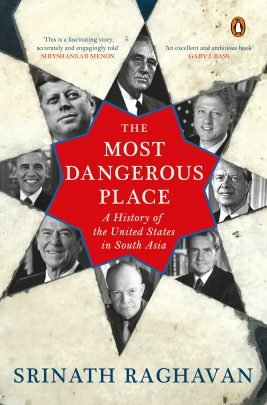A History of United States in South Asia
Author: Srinath Raghavan
Publisher: Penguin Allen Lane, 2018, pp. 472
Price: 799/-
Book Review by:Srishti Singh
No policy planning document has survived contact with the vicissitudes of international politics.” The book, ‘The Most Dangerous Place: A History of United States in South Asia’, paraphrases Helmuth von Moltke in the context of how the assumption that US foreign relations typically tend to treat South Asia as peripheral to the concerns of American policymakers, may prove to be sincerely misleading. The author, Srinath Raghavan, submits that the periphery often ends up imposing itself on policymakers concerned with core challenges and his book is well supplied with the history of United States and South Asia acknowledging the theory. The text develops this rationale beyond the most overwhelming coincidence of the India-China War and Cuban Missile Crisis in 1962. For instance, in recognising how – “Historians have in recent years encouraged us to understand the Indian rebellion of 1857-58 and the American Civil War of 1861-65 as part of a series of inter-regional shocks that divided the nineteenth century and had global ramifications.”
‘The Most Dangerous Place’ is a compelling and consuming read that accurately reproduces the history of United States in South Asia across the spectrum of traditional exchanges and official relationships. The book borrows its label from the US President Bill Clinton’s vexed remark of 2000, “The most dangerous place in the world today, I think you could argue, is the Indian subcontinent and the line of control in Kashmir.” The author’s motive is to draw a frame of reference for American hegemony in South Asia that has observed interplay of coercion and consent over the past two centuries. Srinath Raghavan has worked on three key dimensions of the United States’ interaction with the South Asian region – Power, Ideology and Culture. “If ideology and culture set the parameters for the pursuit of power, strategic and economic encounters also impinged on the domain of culture and shook the kaleidoscope of ideology.” Hence the book is a review and more so an evaluation of the historical experiences from the perspectives of both governance and diplomacy, and people of the two regions – from traders and missionaries, economists and musicians, architects and agronomists.
In chapter one, ‘Fortune, Fantasy and Faith’, Srinath Raghavan documents an exhaustive Indo-American trade narrative for the period 1784 to 1878, and then colours the vital statistics with human impressions. For example, to illustrate diminishing trade with India, the author notes factual nuances of the United States Embargo Act of 1807 and then recites a wistful passage from Boston merchant J.D. Alden’s journal,
“Though absent I recall thy charms
And wish – as lovers when part –
I’d like the vine, a thousand arms
to clasp thee, hold thee, to my heart.”
The book maintains this equilibrium in historical records and implied anecdotes till the conclusion. In chapter ten – ‘The New Century’, the author explains how globalisation enabled the diffusion in India of American popular and consumer culture to an unprecedented degree. This argument is then substantiated by a series of case studies referring to adaptation of American brands to Indian sensibilities. Perhaps, it is this paradigm that assigns a sense of immediacy to the book.
For the readers, this book becomes the source of a binary discourse. One, of singular lessons presented by American intervention in South Asia that includes streamlining the education model and mushrooming an ecosystem of modernity. Two, of complex geopolitical learning induced by American influence in South Asia that incorporates the nuclear pursuits and Islamist politics of the region. On these lines, the reading contains overtones of frequently silent interchanges between America and South Asia, primarily India, Pakistan and Afghanistan.
‘The Most Dangerous Place’ is intended less as a portrait of the geographies than as a picture of an era through which America and South Asia have co-existed and mutually transitioned. It is a fascinating book written with skilled research and generous annotations. Srinath Raghavan has done absolute justice to his repute as India’s leading historian and political analyst. When measured against the archival base and literary superstructure, the reading conveys a relative charm in Indo-American affinity. The conclusion of the book commences with Walt Whitman – Passage to India (1870),
“Passage to you, your shores,
ye aged fierce enigmas!
Passage to you, to mastership of you,
ye strangling problems!
You, strew’d with the wrecks of skeletons,
that, living, never reach’d you!”
In the contemporary world, when the United States is expressing an erratic etiquette under the Trump administration and the protectionist culture; Afghanistan is collapsing under the Taliban harassment and internal conflict; Pakistan is anticipating a change in the Civil-Military relations with the coming of a new government; and India is beholding transformational challenges in becoming an emerging power, the book attains greater significance. By illuminating the patterns of the past, this sweeping history of United States in South Asia becomes a source of encouragement to researchers to delve deeper into the paradoxes graphing the unique inflexion points of the most dangerous place in the world.
(Srishti Singh is a student of Journalism at the University of Delhi and is currently interning with the India Foundation.)
(This book review is carried in the print edition of July-August 2018 issue of India Foundation Journal.)




